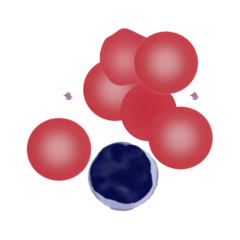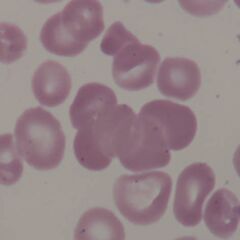Anisochromia: Difference between revisions
From haematologyetc.co.uk
(Created page with " '''Derivation:''' ''From latin “fasten with glue”'' ---- '''Description''' Erythrocytes linked together to form irregular clumps of varying size. <gallery mode="nolines" widths="240px" heights="240px" border="1px" > File:RC_C_agglutination_G.png|link={{filepath:RC_C_agglutination_G.png}} File:RC_F_Agglutination_G.jpg|link={{filepath:RC_F_agglutination_G.jpg}} </gallery> <span style="font-style:italic; font-size:90%;'' > '''Appearance:''' The key points a...") |
No edit summary |
||
| Line 1: | Line 1: | ||
'''Derivation:''' ''From | '''Derivation:''' ''From the Greek Aniso (unequal) and Greek Chromia (referring to colour or shade)'' | ||
---- | ---- | ||
| Line 7: | Line 8: | ||
'''Description''' | '''Description''' | ||
This is a simple term that describes variation of colour between the red cells on blood smears; the term does not imply the nature of that variation or a pathological cause – just that different red cell have a different shade! | |||
| Line 24: | Line 26: | ||
''' | '''Pitfalls''' | ||
The main pitfall is that the term is selected to describe the appearances of a film but falls short of describing what is happening: cells that may contribute to variation in color may include: dense hyperchromic erythrocytes, hypochromic erythrocytes, reticulocytes or stippled cells – these should be identified individually. | |||
'''Recommendation''' | |||
The term is better avoided: it is generally more useful to indicate the precise types of cells present. The example images show films that could be described as “anisochromic”, but note that in each case there are more specific terms that describe the cell types that contribute to the appearance. | |||
---- | |||
Revision as of 13:34, 6 March 2023
Derivation: From the Greek Aniso (unequal) and Greek Chromia (referring to colour or shade)
Description
This is a simple term that describes variation of colour between the red cells on blood smears; the term does not imply the nature of that variation or a pathological cause – just that different red cell have a different shade!
Appearance: The key points are that the red cell groups are very irregular. In many cases they will include cells that have been damaged by the underlying immunological process (shown in the cartoon image as a spherocyte and irregularly contracted cell with the agglutinated group). A small image from a clinical case is shown for comparison.
Pitfalls
The main pitfall is that the term is selected to describe the appearances of a film but falls short of describing what is happening: cells that may contribute to variation in color may include: dense hyperchromic erythrocytes, hypochromic erythrocytes, reticulocytes or stippled cells – these should be identified individually.
Recommendation
The term is better avoided: it is generally more useful to indicate the precise types of cells present. The example images show films that could be described as “anisochromic”, but note that in each case there are more specific terms that describe the cell types that contribute to the appearance.

